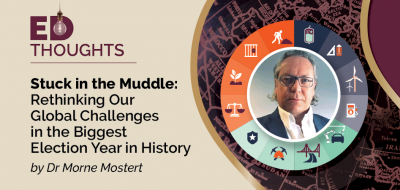Lessons for leaders in how to rebuild trust
A lack of trust in leadership in the workplace can negatively impact work performance. Here are 5 steps to rebuild an organisational culture of trust.
The recently released results from the Edelman Trust Barometer revealed just 20% of our populace trusts the Ramaphosa government. That means South Africa now ranks worst out of 28 nations for trust in government. Having the least trusted government in the world is quite a claim to shame. But it is possible to turn the situation around.
Journalist Alec Hogg used Brazil as a case study for swiftly clearing out corruption. There are plenty of positive private sector stories too. A lot of it comes down to rebuilding trust in organisational culture, which takes strong vision, planning and consistent commitment.
Brazil’s Operation Carwash is a famous case study in the efficacy of the police in rooting out widespread corruption. Targeted at money laundering, it has led to waves of arrests in the private and public sectors. It’s considered the largest corruption investigation in Brazil’s history.
A key idea behind it is that no one is above the long arm of the law. When that simple idea is properly put into effect, change happens. Hogg believes ‘team Ramaphosa’ can learn a lot from Brazil and its transformed, now far more trustworthy leadership. Much of this comes down to having the will to act.
To start with, we need to rebuild trust following State Capture. “This has created a culture of fear and mistrust amongst the mass population and the informed public,” says Lynn McGregor, a USB-ED Faculty Member and Senior Research Fellow at University of Stellenbosch Centre for Corporate Governance in Africa. “This leads to pessimism, suspicion and low morale, which catalyses a lack of motivation and co-operation to change things for the better.”
So, what is required to turn the situation around for South Africa’s government and other entities that have lost credibility? What’s the process to rebuild trust in a leadership team from within an organisation?
Firstly, it’s crucial to identify the true scope of the corruption within the company. McGregor says this takes intelligence, observation, research and paper trails. “It needs to be a systematic process over time. Any accusations must be backed by infallible proof. It’s important to remove emotions from what needs to be done.”
Then, how to rebuild trust in a leadership team where there’s toxic mistrust? McGregor says both the Chairperson with regard to the board and the CEO with regard to the Executive Committee must communicate to the leadership team that any untrustworthy behaviour will not be tolerated. This means:
- Outlining clear policies and rules regarding what classifies as acceptable behaviour in terms of honesty and trustworthiness.
- Defining a clear code of values that align to the Constitution and King Reports. Everyone in the leadership team must agree to these and understand what it means to put them in practice. Once defined, a communication strategy must be agreed on. If integrity is consistently rewarded, then it cascades. Communication is the key.
- Defining clear consequences should any of the rules be broken. Ensure each person signs off on these. For example, if a team member is discovered acting incongruously to the rules, he or she commits to immediately resign.
- Ensuring the team have a united mission and values system to ensure they come across as a powerful cohesive force with no deviations.
It’s also imperative to start to mend relationships. It’s destructive when nobody in a team trusts anyone else. Restorative justice usually means rehabilitating offenders through a programme that focuses on reconciliation. These principles can be applied in office – it can be beneficial to get parties who have previously ‘offended’ each other together for mediation and counselling.
McGregor suggests gathering the team together for shared sessions, where each director is asked what they need in order to trust their peers. This should apply both to the board and the executive committee. The Chairperson for the board and the CEO for their executive team must spell out what is expected from each director and the and clearly define acceptable and unacceptable behaviours.
The team must collectively decide what the most effective measures to take may be, and what rules should ensure these are enforced. Particularly difficult team members should be conversed with individually ahead of the shared sessions, “Listen to the person; if he or she would rather not remain in the team, find out how this can be arranged. Give honest, factual feedback that you can back up with evidence.”
Another issue is that a culture of mistrust often brings about fear and paranoia. Open communication needs to be encouraged, along with whistleblowing. McGregor says that clear policies must be outlined regarding whistleblowing and bullies. Any incidents of bullying must be dealt with immediately. Sometimes, it can be good to involve external organisations to mediate and facilitate better intra-personal interaction and communication between the group. A further result of mistrust is an atmosphere of pervasive negativity. To address this, it’s important to consistently call out positive results and reward individuals and groups who do well. Additionally, creative problem-solving should be encouraged through a culture that encourages rapid ideation. Allowing for constructive failure is a big part of this.
Ultimately, it’s vital to instil a sense of ‘being in it together’. A feeling of collective wellbeing comes about from rewarding good work, and changing the policy, values and beliefs of the organisation. Consistency is critical. You need to show that focusing on being part of a group is better for everyone. Training in interpersonal dynamics may make a big difference. It’s vital to have time allocated for people to share whether progress has been made and what more needs to be done. Leaders need to be simple, clear and consistent – repeat your message in your words and actions until you are believed.
Conclusion:
Enrol your leaders in a leadership course such as the Management Development Programme to instil the self-mastery required for the task. Rebuilding trust in organisational culture is not easy. It’s a sustained process that takes great self-awareness from the leaders at the top. Skills training can make a world of difference!
written by





